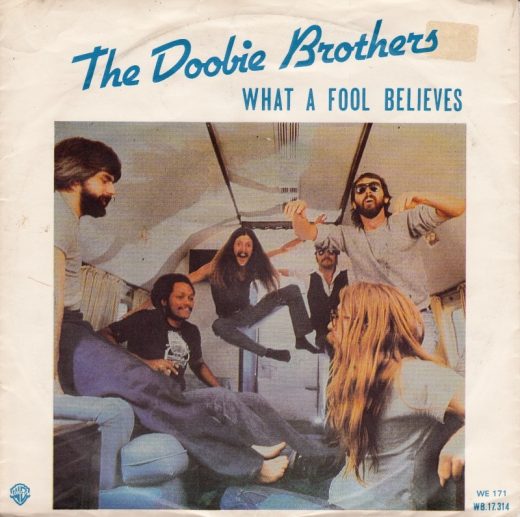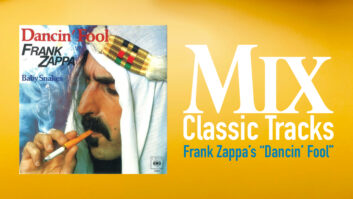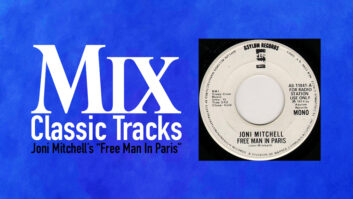 No one was more surprised than Michael McDonald when the song he wrote for the Doobie Brothers, “What a Fool Believes,” earned Grammys for Record of the Year and Song of the Year, as well as Best Arrangement Accompanying Vocalists at the 1980 awards ceremony. The album it was on, Minute By Minute, also took Best Pop Vocal Performance by a Duo, Group or Chorus, even though, McDonald recalls, the record executives had predicted the opposite.
No one was more surprised than Michael McDonald when the song he wrote for the Doobie Brothers, “What a Fool Believes,” earned Grammys for Record of the Year and Song of the Year, as well as Best Arrangement Accompanying Vocalists at the 1980 awards ceremony. The album it was on, Minute By Minute, also took Best Pop Vocal Performance by a Duo, Group or Chorus, even though, McDonald recalls, the record executives had predicted the opposite.
“The famous quote at one of the production meetings was, ‘This is the end of these guys. This is over.’ We weren’t so sure it wasn’t true ourselves,” McDonald admits. “We felt like we weren’t sure what we had done. We dove in head first and made the record.”
The song had been brewing for a couple of years. In fact, during the recording of the Doobies’ previous album, Livin’ on the Fault Line, McDonald would play the riff for producer Ted Templeman and he would always say, “You gotta finish that song. That’s a hit.” McDonald was forever replying, “Yeah, yeah, I will, I will,” but it eluded him, until the day Kenny Loggins drove down to North Hollywood from his home in Santa Barbara to write with McDonald for the very first time. Upon his arrival, he heard McDonald noodling around on the piano, playing that riff.
“I answered the door and he said, ‘Whatever that was you were playing, can you remember it?’ I said, ‘Sure, it’s something I’ve been messing around with,’ and he said, ‘That’s the one I want to write,” McDonald recalls. “We wrote a bridge to the song and I think the next day over the phone, we wrote the chorus. It was just one of those ‘right time, right place, right people’ things.”
Recording the song, however, did not flow as easily. In fact, McDonald says that the two weeks spent at Amigo Studios in North Hollywood cutting the entire album was fairly tortuous, although he says there was one bright spot: “There was a basketball net in Studio A and one of my fondest memories is that I got to shoot baskets with James Taylor, who was recording in the next studio.”
Amigo’s Studio A was where the Doobie Brothers cut all of their tracks, recalls McDonald, and according to him, it was not “exactly an interior designer’s fantasy. It was like many studios of its time: fluorescent lights, white linoleum floors, walnut paneling and orange fabric walls. Even the couches were uncomfortable.”
The console was a classic API and everything was recorded on 3M 2-inch 24-track machines. And although McDonald doesn’t recall the specific outboard gear used other than “it was mostly stuff of that era like the 1176 UREI limiter/compressor,” he does recall the arduous process. “We would work until three or four in the morning and either sleep on the floor in the studio or go home and be back by 10,” McDonald recalls. “Those were the crazy days of recording — it’s all you did and all you thought about, and we were immersed in the thing.”
The recording of “What a Fool Believes,” in particular, was brutal, McDonald emphasizes. “We cut so many versions of it. It was just a funny song to learn to play. We’d have a good verse section in one take and then the chorus would fall apart. We had big boxes of 2-inch tape piled to the ceiling on just that one tune. We had gone through God knows how many rolls of tape trying to get that song. We just didn’t feel that we were capturing the groove. I believe Ted Templeman played drums on that track.”
Templeman confirmed that fact in Fred Bronson’s The Billboard Book of Number One Hits: “We tried to cut it over and over and over, and we couldn’t get it to where it felt right. We must have cut that thing for five or six days straight. I finally — just to get the feeling right — ended up playing drums on it myself along with [regular Doobies drummer] Keith Knudsen. I just wanted a sort of floppy feel and if you listen to it, it’s really kind of a floppy record. It flops around, the drums aren’t perfect, nothing’s perfect on it. You know, a Rolling Stones record may not be perfect, but it’s got a feel to it.”
Little Feat keyboardist Billy Payne and McDonald spent a day working on the synthesizers for the track. “He played some and programmed some for me, and we started building parts on the track, which brought the thing to life a little bit,” McDonald says. “The opening riff was an acoustic piano [a 7-foot Steinway] accompanied by an Oberheim 8-voice analog synthesizer. I still own the Oberheim I used on the session.
“We tried a lot of different wacky overdubs on that track, like at one point, we were stomping on a piece of plywood on the floor to re-create that kind of Four Seasons ’60s pop thing, like on ‘Sherry’ and ‘Walk Like a Man,’ and some of the Beach Boys’ tracks,” he continues. “We were trying anything. We felt the track had a certain pop sensibility that was kind of retro in a way, and that always seemed to be where our heads were. Whenever we cut a track, we were constantly comparing it to stuff that was done years ago, either production value-wise or song-wise.”
There were so many takes on the song that McDonald isn’t sure if the vocal — most likely recorded with a Neumann U87 — ended up being cut live. “Whenever we cut a track live, I sang a live vocal, but it seems to me when I look back, most of the time I wished the live vocal was what we did use. Most of the time, I didn’t have all the words at the point of the first cutting. That particular song was written and we did have all the words, so it’s quite possible that was a live vocal. In any case, where we could use the live vocal we did, and I would just punch in and fix any words I flubbed.”
Classic Tracks: Cyndi Lauper’s “Girls Just Wanna Have Fun”
Despite the many takes, McDonald says that Templeman truly knew what he was after. “As we were playing it, we were getting increasingly more frustrated, as you can imagine, snapping at each other. There were some pretty famous comments after each take toward the end,” he says with a laugh. “There were too many expletives to say them in print, but it was like, ‘I hate this blankety blankety blank song.’ We finally got so frustrated, we just quit. Ted said, ‘Don’t fret, I know we’ve got a take here. I know which one it is.’ I’m looking at boxes of tape, literally, piled to the ceiling, and he says, ‘Take number one on box three, and then from the bridge out, on take number one, box 12.’ I said, ‘Come on, Ted!’ And he said, ‘I’m telling you, I’ve kept track of it the whole day.’ So we pulled out those two boxes of 2-inch tape, and right then and there, they cut it and spliced it together. That was the take of ‘What a Fool Believes’ that you hear on the radio.”
By the time the mixing process began, McDonald was exhausted. “I only lived a couple of blocks from the studio, but when Ted called me to come to hear the mix, I said, ‘Ah, I couldn’t listen to it and be objective at this point. If you think it’s good, it’s fine with me.’”
Thankfully, Templeman had faith in the song and its recording. “When I hear [McDonald] singing those high parts, it just kills me,” he said in an interview years ago. “It just sounded like a hit. It was pretty obvious.”
It may have been obvious, if only to Templeman. McDonald got a different reaction when he played it for his friend and group publicist at the time, David Gest (recently famous as Liza Minelli’s husband). “We were sitting in the May Company parking lot on Laurel Canyon and I had rough mixes of the album. He said, ‘Put it on, I want to hear it.’ I said, ‘I don’t know.’ He said, ‘I’ll tell you the truth.’ I knew he’d be honest with me. I played the whole record and I said, ‘Well, what do you think?’ And he said, ‘I think it’s a piece of shit.’ I said, ‘Yeah, I’m not sure I don’t agree with you.’”
Gest and any of the nay-sayers were probably comparing the songs on Minute By Minute to the disco sound du jour that dominated the airwaves. The day when “What a Fool Believes” hit Number One — April 14, 1979 — it was completely different from the Number Two song, the disco classic “I Will Survive,” and the Number Three tune, Ami Stewart’s disco treatment of “Knock on Wood” — proof that an R&B-infused pop record could still be appreciated.
“What a Fool Believes” was also very different from the last (and only other) Number One song that the Doobies ever had, the folksy, gospel-flavored “Black Water” in 1975, prior to McDonald’s joining the fold. That song, and other Doobie compositions pre-McDonald, had more of a raucous rock feel. McDonald entered the picture in 1975, when recommended by Doobie bassist Jeff “Skunk” Baxter, with whom McDonald had played in Steely Dan’s band. His first recorded effort with the Doobies was the 1976 Takin’ It to the Streets, and immediately you could hear McDonald’s R&B inflections, both in song structures and vocals. They charted well with the title track, written by McDonald, followed by “It Keeps You Runnin’,” and his influence remained throughout the latter ’70s and early ’80s. To this day, McDonald remains modest and humble about his place in the Doobies.
“I think some of the strongest material the Doobies will ever play is the original stuff they did, which Tommy [Johnston] and Pat [Simmons] wrote,” he says. “I was only thrilled that along that period of time, Minute By Minute and Takin’ It to the Streets kind of seemed to fit in there somehow and find a place in the show. I never really thought anything I did with the band ever replaced what the band was originally.”
Nonetheless, it can’t be denied that “What a Fool Believes” and the attention the group received at the 1980 Grammys catapulted the band to another level. It became even more obvious, when even Gest changed his tune.
“I’ll tell you a funny story,” McDonald says. “Under my pile of junk on my piano was the envelope I had written the lyrics to that song on, with some drawings I had doodled while I was thinking about the verses. One day, David came over and he was standing by the piano. He said, ‘Hey, can I have this?’ I thought, ‘It’s just an envelope with some words on it.’ The next time I saw it, it was about two years ago when I was in the Hard Rock Café in Philadelphia. I was eating and looked up, and just above my head was a frame with a bronze plaque with the envelope with the lyrics.”







